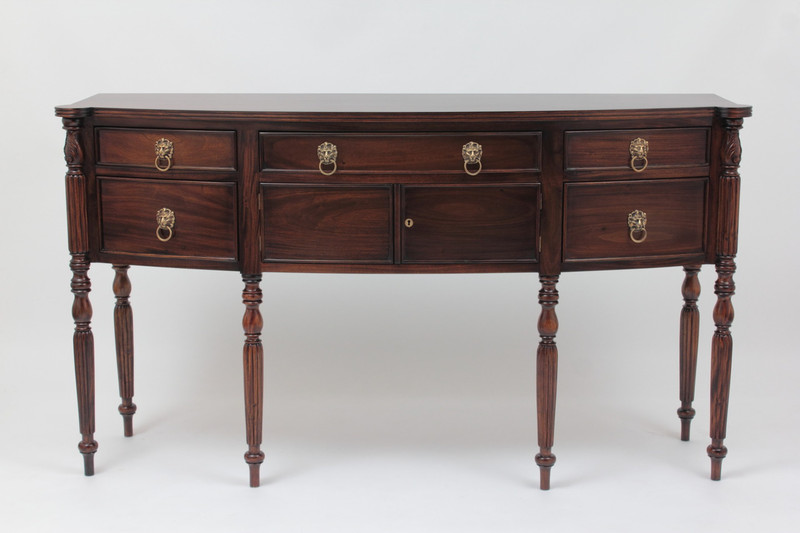- Home
- Learn About Antique Furniture and Reproductions
- Resources
- Furniture Wood Types
Furniture Wood Types

Different Types of Woods
-
Calamander: Also known as Coromandel or golden ebony, this is a dense hardwood that grows in Southeast Asia and other parts of the Pacific region. Calamander was popular during the Regency period (1795 – 1837). It is light brown, striped, and mottled with black lines. This valuable wood was often used for veneers and banding.
-
Cherry: Also known as fruitwood, American black cherry wood grows throughout North and South America. This beautiful hardwood has natural pink undertones, but it can also vary from light to dark with age or exposure to light. Cherry was popular during the Queen Anne and Federal eras, because it resists warping and is easy to carve.
-
Elm: This soft hardwood has an expansive territory in temperate regions all over the world. Fine furnishings were also made from elm that grew throughout central and eastern Europe, but most of the elm used to make antiques came from America and England. American and English elm heartwood tends to vary from light brown to gray in coloring, with an interlocking grain and resistance to splitting. This wood was often used during the Colonial era (1700 – 1780).
-
Kingwood: Also known as prince’s wood, this is a dense wood species that only grows in Brazil and is closely related to rosewood. Kingwood reached its height of popularity during the17th and 18th centuries. Its coloration varies from brown to purple, with either fine dark stripes or pale streaks and irregular swirls. This wood was often used for inlays and veneers, because of its straight grain, natural luster, and resistance to decay.
-
Mahogany: This tropical hardwood is native to South America and the West Indies. With its close, straight grain and a rich coloration ranging from light red to dark brown, mahogany has enjoyed long-lasting eminence since the Colonial era. This wood also offers dimensional stability and resistance to decay, making it ideal for fine cabinetry and furniture.
-
Maple: This is a light-colored hardwood that grows abundantly throughout the eastern United States. Maple features a fine texture and an even grain. When referred to as birds’ eye maple, the wood features a speckled pattern. It was often used during the Regency period as well as in Victorian and Edwardian bedroom suites.
-
Oak: This slow-growing wood species grows abundantly in temperate and tropical climates throughout regions of Asia, Europe, and North America. Oak is usually hard and pale in coloration, but it tends to darken over time with age and polishing. This heavy, solid wood features an open grain and was often used during the Georgian period (1714 – 1820).
-
Pine: This family of conifers includes over 100 species, including both hard and softwoods, which grow throughout the Northern Hemisphere in many parts of the world. In the United States, most furniture makers used Eastern White Pine, Sugar Pine, and Yellow Pine, all of which have knots and a natural grain that add individuality to each piece of furniture.
-
Rosewood: This richly hued, tropical hardwood grows throughout Africa, southeast Asia, and parts of South America. It varies in coloration from brown to dark red, with an almost black wavy grain, and is noted for its dimensional stability. Rosewood was often used for inlaid decoration and veneers, but it was also used to make traditional European furniture.
-
Satinwood: This tropical hardwood is native to southeast Asia, India, and Sri Lanka. It was first imported from the East Indies, used for inlays and veneers during the Georgian and Hepplewhite (1780 – 1810) eras. Its light, yellowish coloration made it suitable for painting. Satinwood made a comeback during the Edwardian period (1901 – 1911).
-
Sycamore: Also known as buttonwood, this is a fast-growing soft hardwood that is native to the southeastern United States. It also grows throughout southeastern Europe and Asia. Sycamore features a fine grain and delicate coloring, which varies from white and light tan to dark reddish-brown. It was used to make musical instruments, trunks, and more.
-
Walnut: This is a deciduous hardwood native to eastern North America. Its coloration varies from light golden brown to light gray brown, with a rich, close-grained pattern. Burr walnut refers to walnut that features knotty whorls in the grain, which was commonly used for veneers on large pieces of furniture. Walnut was popular during the William and Mary (1690 – 1730), Queen Anne (1720 – 1760), and Chippendale (1755 – 1790) eras.
Knowing the different types of woods used to handcraft antiques may be very helpful in determining whether you have an antique or an antique reproduction. At Laurel Crown, we specialize in building antique reproductions using the finest mahogany and pine.









